ViaCord
Empowering healing for generations to come
 For over 20 years, ViaCord has been providing the highest quality, umbilical cord blood stem cell collections for families, and has been involved in cutting edge research to find new stem cell therapies for diseases like cancer, juvenile diabetes, and heart disease. Our mission is to provide the highest quality stem cell preservation service and care to our patients, families, and their physicians. We at ViaCord believe these words are much more than just a promise.
For over 20 years, ViaCord has been providing the highest quality, umbilical cord blood stem cell collections for families, and has been involved in cutting edge research to find new stem cell therapies for diseases like cancer, juvenile diabetes, and heart disease. Our mission is to provide the highest quality stem cell preservation service and care to our patients, families, and their physicians. We at ViaCord believe these words are much more than just a promise.
Why Cord Blood Bank?
Make cord blood part of your family’s plan
Thinking about saving your baby’s cord blood? You’re not alone and chances are you have lots of questions: Does it make sense for your family? Which bank should you choose? Is it worth it?
The fact is, cord blood stem cells are doing amazing things today — healing serious diseases and changing lives for the better. And thanks to a vital research community, the treatment potential for cord blood continues to grow.
Benefits of Cord Blood
Nearly 80 life-threatening diseases — from cancers to blood diseases to immune disorders — can be treated today using cord blood stem cells. The proven effectiveness of these amazing cells has made cord blood the fastest growing source of stem cells in pediatric transplants, and thanks to advancements in research its treatment potential continues to expand.

Looking ahead. Exploring new uses for cord blood.
Researchers around the globe are exploring new uses for cord blood. A search on ‘cord blood’ at ClinicalTrials.gov will provide details on hundreds of studies taking place in an effort to increase therapeutic use of these amazing cells. In fact, children of ViaCord families have participated in two major clinical trials for regenerative cord blood stem cell treatments (one for cerebral palsy and another for type 1 diabetes). Both required children to have access to their own cord blood to participate.
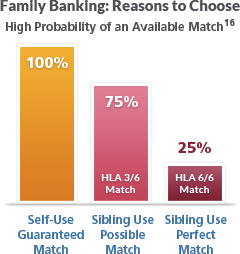 Family values. The principles of matching.
Family values. The principles of matching.
The effectiveness of cord blood stem cell therapy depends on many factors, with one of the most important being stem cell matching. Doctors determine stem cell matching based on human leukocyte antigen (HLA) markers. Passed down from parents to their children, these markers act like cell fingerprints, letting the immune system know which cells belong in the body and which cells are foreign to it. If a patient’s HLA markers exactly match those of the new stem cells being introduced, the patient’s body will readily accept the cells. If the HLA match is close but not perfect, chances are still favorable that the patient’s body will accept the cells. By storing cord blood from each child, parents can increase the chance of finding the best source for a match.
With newborn stem cells, youth has its advantages.
Beyond the matching benefits of family cord blood banking, cord blood stem cells have a special characteristic that makes them more effective than other types of stem cells. Simply put, they’re young and inexperienced — and that’s a good thing. Cord blood stems cells are immunologically naïve, which means they are less developed and more flexible than other adult stem cells such as bone marrow. When used in treatment, cord blood stem cells are less likely to “cause trouble” and therefore can more easily integrate themselves into a patient’s body.
What is Cord Blood?
 The blood within your newborn baby’s umbilical cord contains young stem cells that can renew themselves and become specialized. These cord blood stem cells have been proven in treatment to help children replace damaged blood cells with healthy ones and strengthen their immune systems. Cord blood banking is the process of collecting and storing these stem cells for potential medical use.
The blood within your newborn baby’s umbilical cord contains young stem cells that can renew themselves and become specialized. These cord blood stem cells have been proven in treatment to help children replace damaged blood cells with healthy ones and strengthen their immune systems. Cord blood banking is the process of collecting and storing these stem cells for potential medical use.
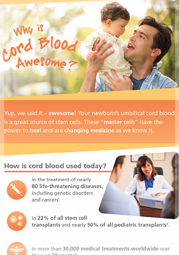
Why is cord blood special?
Nearly half of all pediatric transplants worldwide now involve cord blood. To date, over 30,000 transplants have been performed using these amazing healing cells, but it only takes one happy ending to understand why cord blood is so special.
- Baby Harlow at 3 months used her own cord blood to treat a tumor
- Taylor used her sister’s cord blood to treat her leukemia
You’ll find more compelling experiences in our Families Stories section. For a quick summary of all things that make cord blood awesome, see our easy to read (and share) infographic.
Collection is fast, simple and painless.
The collection of your baby’s cord blood happens the day your baby is born. It won’t harm mom or baby and it won’t disrupt your birth plan. After delivery it’s standard procedure for your doctor or midwife to clamp and cut the umbilical cord. Using ViaCord’s collection kit, they will then insert a needle into the cord to collect the remaining blood. Once the collection is complete, they will seal the bag, attach the pre-printed label with your family’s information, and place it in the collection kit. A medical courier will pick up the kit from your hospital room and transport it to ViaCord’s state-of-the-art lab and storage facility, where lab specialists will process the cord blood in preparation for long-term storage. For more information, visit our Collection & Transport page.
What is Cord Tissue? Why is it unique?
 The tissue found in your baby’s umbilical cord contains a special kind of stem cell — different from cord blood stem cells — that research indicates has the potential to treat medical conditions affecting cartilage, muscle, and nerve cells. Research suggests that cord tissue stem cells have the unique ability to rapidly regenerate and differentiate themselves – an ability that could have invaluable ramifications for future cord tissue therapies. ViaCord’s cord tissue banking service includes the collection, extraction, and storage of these remarkable cells.
The tissue found in your baby’s umbilical cord contains a special kind of stem cell — different from cord blood stem cells — that research indicates has the potential to treat medical conditions affecting cartilage, muscle, and nerve cells. Research suggests that cord tissue stem cells have the unique ability to rapidly regenerate and differentiate themselves – an ability that could have invaluable ramifications for future cord tissue therapies. ViaCord’s cord tissue banking service includes the collection, extraction, and storage of these remarkable cells.
What’s as exciting as cord blood? Let’s talk tissue.
Umbilical cord tissue provides an abundant source of mesenchymal stem cells (MSCs). These special cells are being studied in great detail for their ability to regenerate bone, cartilage, tendons and neurons. To be clear, there are no medical treatments currently available today using stem cells extracted from cord tissue.
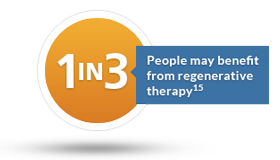
However, a significant amount of research is underway to better understand their potential value, underscoring their importance to the scientific community. Researchers are focusing on a wide range of potential treatment areas, including Parkinson’s disease, Alzheimer’s, liver fibrosis, lung cancer, and sports injuries.
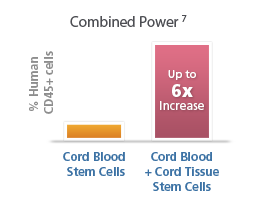
Newborn stem cells are found in both the cord blood and the surrounding tissue. Saving both – cord blood and cord tissue – means more stem cells, more treatment options, and more healing potential. For detailed information, visit our Emerging Research page.
How cord tissue collection works
Just like ViaCord’s cord blood banking service, our tissue banking includes the collection and preparation of treatment-ready cells. After your doctor or midwife has collected your baby’s cord blood, they will collect as much of the umbilical cord as possible and place it in the sterile, protective storage cup provided in your ViaCord collection kit. Both the storage cup and cord blood collection bag are then placed in the kit, which is picked up by a medical courier and transported to ViaCord’s stem cell processing lab and storage facility. There, ViaCord’s lab specialists extract the stem cells from the umbilical cord tissue, prior to storage, to prepare the cells for future medical use.
How Newborn Stem Cells Work
Stem cells are the basic building blocks of life. They are found in the body’s organs, tissues, blood, and immune system and have the ability to regenerate into additional stem cells or differentiate into specialized cells, such as nerve or blood cells. This remarkable ability makes them invaluable in medical treatments. When transplanted into a patient’s body, stem cells can repair or replace the patient’s damaged or diseased cells, improving the patient’s health and, in many cases, saving the patient’s life.

The umbilical cord: Nurturing life after pregnancy.
Throughout pregnancy, the umbilical cord functions as the lifeline between mom and baby, carrying nutrient-rich, oxygenated blood from the placenta to the developing baby via the umbilical vein. The baby, in turn, pumps nutrient-depleted, deoxygenated blood back to the placenta through the umbilical arteries. The cord tissue surrounding the umbilical vein and arteries acts like a cushion, preventing twisting and compression to ensure the cord blood flow remains steady and constant.
The umbilical cord is a rich source of two main types of stem cells: cord blood stem cells and cord tissue stem cells. Through the science of cord banking, both cord blood and cord tissue stem cells can help nurture life, long after a baby’s birth.
Flexible & accessible: A win-win for umbilical cord stem cells.
Umbilical cord stem cells share a special property that sets them apart from adult bone marrow stem cells: flexibility. This special property enables them to more easily adapt to a patient’s body during transplant. As a result, a patient’s body is less likely to reject the cells, increasing the chances for a successful outcome.
Another benefit of cord stem cells is their easy accessibility. Collecting umbilical cord stem cells is a straightforward, quick, and painless procedure for both mom and baby. Collecting bone marrow stem cells, on the other hand, involves a more complex surgical procedure that can put the bone marrow donor at risk for medical complications.
Frequently Asked Questions
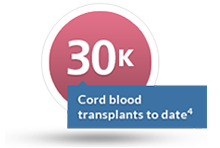 With over 30,000 cord blood treatments worldwide to date, many parents want to know more. Our FAQs are here to help you make sense of it all. Find answers to your questions on all things cord blood banking, cord tissue banking, and ViaCord’s state-of-the-art laboratory.
With over 30,000 cord blood treatments worldwide to date, many parents want to know more. Our FAQs are here to help you make sense of it all. Find answers to your questions on all things cord blood banking, cord tissue banking, and ViaCord’s state-of-the-art laboratory.
Click on a topic below to open FAQs. Don’t see your answer? Give us a call.


